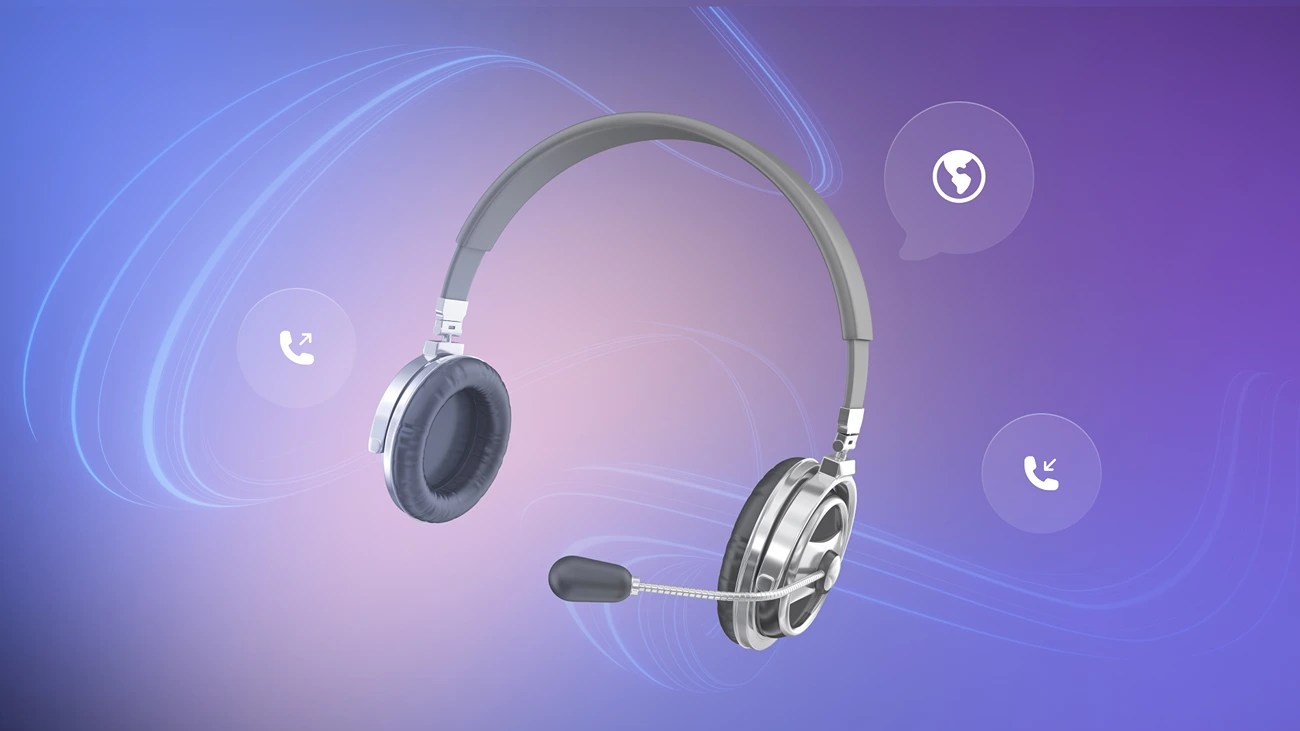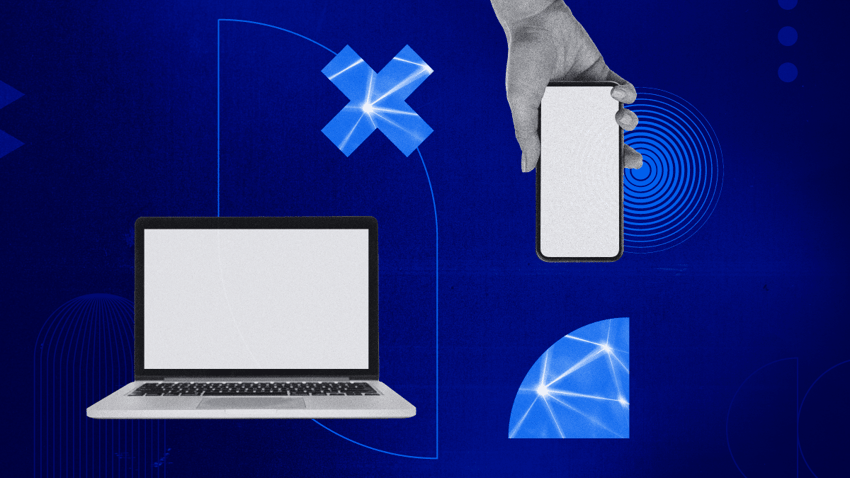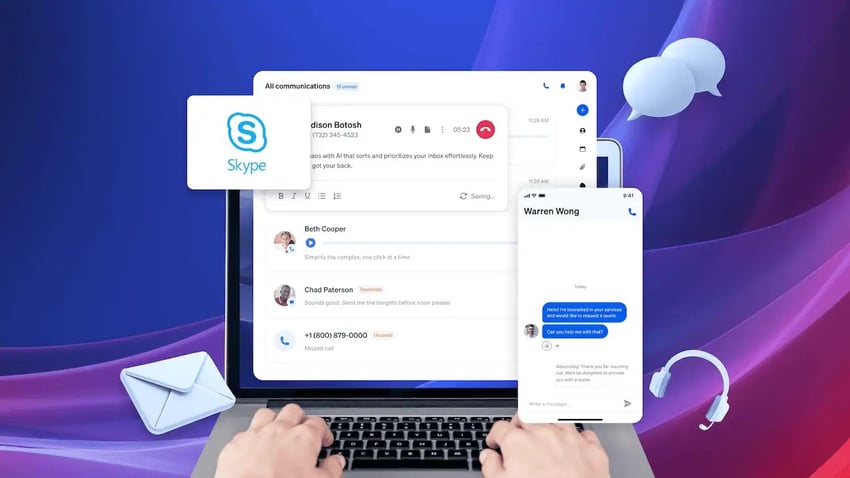Clear, reliable communication isn’t optional, it’s the backbone of every successful business. Whether your team is closing deals, resolving support tickets, or collaborating remotely, poor audio quality can derail conversations and damage your customers’ experience.
Dropped calls, muffled voices, and constant headset replacements cost you time, money, and a good customer review (not to mention frustrate employees!). The right VoIP headset eliminates those headaches, keeping your team connected and your CSAT scores high.
That’s why we’ve done the research for you. In this guide, we break down the 5 best VoIP headsets of 2025, comparing their features, comfort, and value so you can choose the perfect fit for your business.
TL;DR Top 5 VoIP Headsets
- Jabra Evolve2 75: Best for long talk time and superior active noise cancellation
- Yealink WH66: Best for wireless range, offering up to 525 feet DECT range
- Poly Blackwire 5220: Best for affordability, suited for wired users on a budget.
- EPOS IMPACT SC 630 (Sennheiser): Best for premium build quality and durability in a wired monaural design
- Poly Voyager Focus 2: Best for all-day wireless performance and comfort
Why Choosing the Right VoIP Headset Matters
Choosing the right VoIP headset matters because it directly affects call quality, user comfort, and overall productivity.

Call Clarity and Professionalism
VoIP relies on digital audio transmission, so the quality of the microphone and speakers in your headset can make or break communication. A high-quality headset with noise-canceling microphones means crisp, clear voice transmission with less background noise, fewer misunderstandings and repeated questions, and an overall more professional impression with customers or clients.
User Comfort and Health
Most VoIP users wear headsets for long hours, so the wrong headset can lead to:
- Head and ear discomfort from poor design or weight distribution.
- Hearing fatigue if the sound isn’t balanced or too harsh.
- Posture and strain issues, especially if you end up holding the phone or sandwiching it between your ear and shoulder.
Productivity and Efficiency
Hands-free headsets allow mobility and multitasking, like typing notes, looking up files, or handling customer data while talking. And choosing a headset with the right connectivity (USB, Bluetooth, DECT, etc.) means you’ll be switching smoothly between devices, which reduces downtime from technical glitches.
Noise Management in Modern Work Environments
In open offices or remote setups with kids, pets, or traffic noise, noise-cancellation and sound isolation are really important. The right VoIP headset insulates the call agent from distractions and filters out background noise for the person on the other end.
Long-Term Cost Savings
A cheap headset may seem fine at first, but frequent replacements, poor durability, or lost productivity from bad audio add up. A well-chosen, durable headset can lower total cost of ownership and reduce IT support needs.
The right VoIP headset isn’t just an accessory—it’s essential for your business.
How to Choose a Proper VoIP Headset
Choose a headset based on how you’ll use it (call volume, environment, mobility needs), then balance comfort, audio quality, and budget. Remember, the “best” headset is the one that matches your work style, not just the priciest model.
1. Figure Out Your Use Case
- Call center agents: Need lightweight, durable headsets with noise-canceling mics and all-day comfort.
- Remote/hybrid workers: Look for wireless options with strong battery life and easy PC/mobile integration.
- Executives and sales pros: Prioritize audio quality, mobility, and multi-device pairing for client calls.
2. Pick Wired or Wireless
- Wired (USB or 3.5mm): Reliable connection, unlimited talk time, lower cost, but limited mobility.
- Wireless (Bluetooth or DECT): Greater freedom of movement, but battery management and interference can be issues.
3. Check Comfort and Ergonomics
- Adjustable headbands, padded ear cups, and lightweight designs reduce strain.
- Choose mono (single ear) if you want awareness of surroundings, or stereo (dual ear) for immersion and focus.
4. Evaluate Call Quality
- Noise-canceling microphones improve clarity in open offices or home setups.
- Look for wideband audio support (HD Voice) for richer, natural sound.
- Test compatibility with your VoIP platform (Nextiva, Teams, Zoom, etc.).
5. Look at Battery Life and Range (Wireless)
- Talk time: Aim for 8–10 hours minimum; 20–30 hours for heavy daily use.
- Range: Bluetooth ~30–100 ft, DECT up to ~500 ft.
- Charging time: Faster is better, especially if you’re in back-to-back meetings.
6. Consider Extra Features
- Busy-light indicators to show when you’re on a call
- Quick-mute buttons for privacy
- Multi-device connectivity (PC, mobile, desk phone)
- Replaceable parts (ear cushions, batteries) to extend lifespan
7. Balance Budget and Longevity
- Entry-level headsets: ~$50–100
- Mid-range for professionals: ~$150–250
- Premium call-center or executive headsets: $300+
Think total cost of ownership; a durable $200 headset that lasts 5 years may be cheaper than replacing a $70 one annually.
Top 5 VoIP Headsets for Businesses
1) Jabra Evolve2 75
Verdict: Best for long talk time and superior noise cancellation
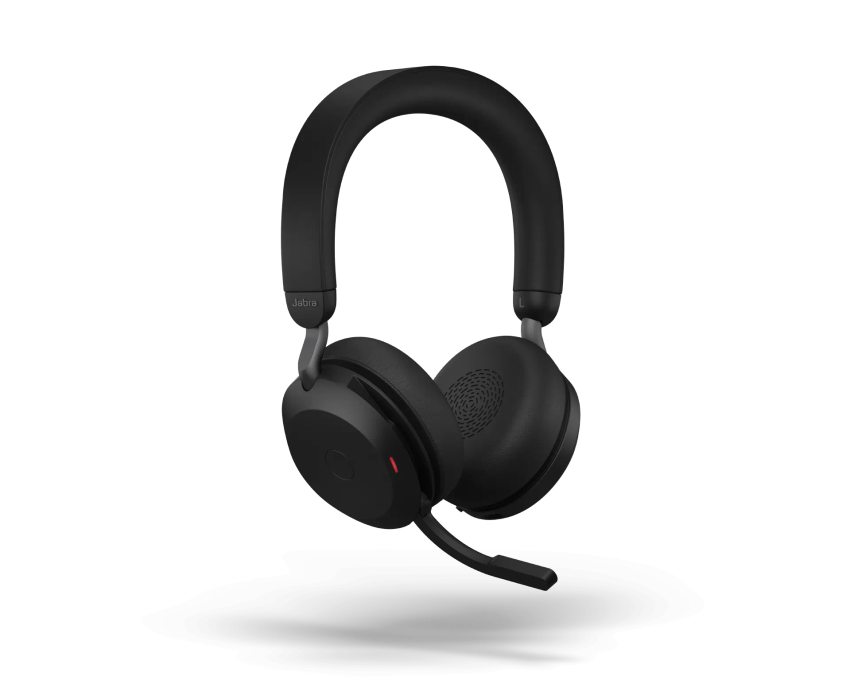
The Jabra Evolve 2 75 is a professional stereo headset. It is wireless with dual connectivity and offers impressive audio for calls. Included is a high-end noise-canceling microphone and ear cushions to avoid background noise. It’s also allows customizable sound profiles with its built-in equalizers, so you can adjust bass, treble, and other settings, making it ideal for long workdays in the office.
Why choose the Jabra Evolve2 75 headset:
- Headset Type: Wireless headset
- Price Range: $340-$465
- Wireless Range: 100 feet
- Average Talk Time: Up to 25 hours
- Charging Time: Approx. 2.5 hours
Potential drawbacks: Only supports Bluetooth/USB (no analog audio jack) and is expensive.
2) Yealink WH66
Verdict: Best for wireless range, offering up to 525 feet DECT range
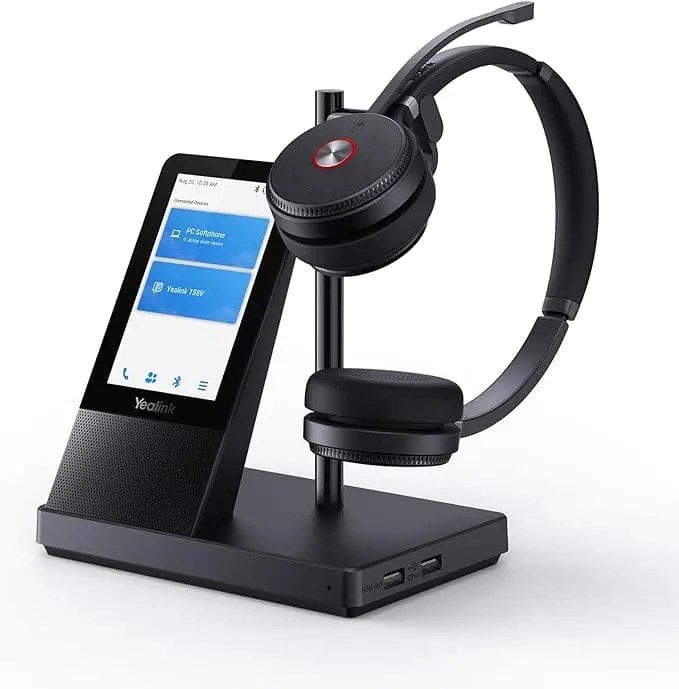
The Yealink WH66 is a wireless headset with a DECT base that acts as a mini workstation, featuring a 4-inch touchscreen, USB hub, and call control. It’s known for its lightweight design, all-day comfort, and advanced noise cancellation, and supports multiple device connections (USB and Bluetooth).
Why choose the Yealink WH66 headset:
- Headset Type: DECT wireless dual or mono UC workstation
- Price Range: $220-$410
- Wireless Range: 525 feet
- Average Talk Time: Up to 14 hours
- Charging Time: Approx. 2.5 hours
Potential drawbacks: Limited compatibility with some desk phones and carrier apps’ advanced call features, sound quality is good but not outstanding for very loud offices, premium price may be a barrier for budget-conscious buyers.
3) Poly Blackwire 5220
Verdict: Best for affordability, suited for wired users on a budget
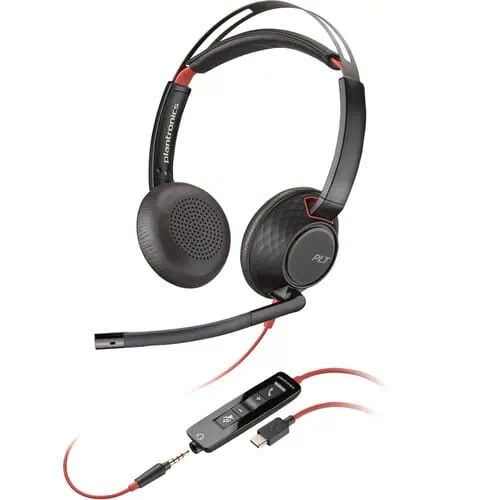
The Poly Blackwire 5220 is a versatile wired USB headset designed for business calls, video conferencing, and multimedia use. With its dual connectivity (USB and 3.5 mm) and noise-canceling microphone, it delivers reliable audio performance at an affordable, mid-range price point.
Why choose the Poly Blackwire 5220 headset:
- Headset Type: Wired stereo headset (on-ear) with USB (or USB-C) + 3.5 mm support
- Price Range: $55-$110
- Cable Length: Approx. 7 feet
- Average Talk Time: n/a
- Charging Time: n/a
Potential drawbacks: Wired headset limits mobility, on-ear design might be less comfortable for very long wear compared to over-ear headsets.
4) EPOS IMPACT SC 630
Verdict: Best for premium quality and durability in a wired monaural design
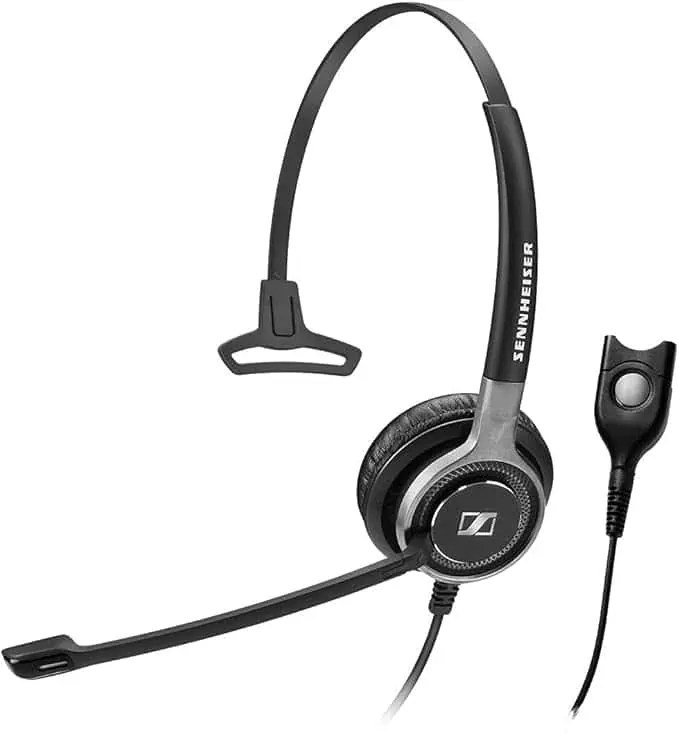
The EPOS IMPACT SC 630 (aka Sennheiser SC 630; EPOS now handles Sennheiser’s enterprise-grade headsets, while the Sennheiser brand focuses on consumer audio products) is a wired monaural headset designed for contact center and office professionals. The “SC” series refers to softphone/computer connectivity. It has outstanding sound clarity with an ultra noise-canceling microphone for clear communication in noisy environments.
Why choose the EPOS IMPACT SC 630 headset:
- Headset Type: Wired monaural/single-sided headset (with Easy Disconnect optimized for use with desk phones)
- Price Range: $75-$200
- Cable Length: Approx. 3 feet
- Average Talk Time: n/a
- Charging Time: n/a
Potential drawbacks: Single-ear design may not suit users who prefer binaural, limited mobility due to wired connection, premium price for a wired headset.
5) Poly Voyager Focus 2
Verdict: Best for all-day wireless performance and comfort
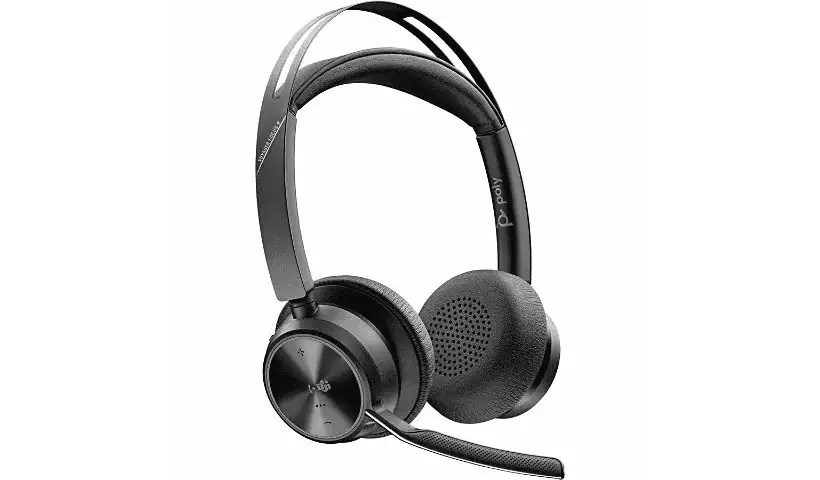
The Poly Voyager Focus 2 is a wireless stereo Bluetooth headset with advanced hybrid active noise cancellation and superior voice clarity, perfect even in noisy environments. It offers up to 19 hours of talk time, smart sensor technology for automatic call handling, and is ideal for all-day use with comfortable padded ear cushions.
Why choose the Poly Voyager Focus 2 headset:
- Headset Type: Wireless stereo (on-ear) Bluetooth, with optional wired/USB mode
- Price Range: $160-$350
- Wireless Range: 164 feet
- Talk Time: Up to 19 hours
- Charging Time: Approx. 2 hours
Potential Drawbacks: Relatively high price point, on-ear design might cause discomfort during extended wear for some users, occasional firmware update issues reported.
Difference Between a VoIP Headset and a USB VoIP Headset
In a nutshell, all USB VoIP headsets are VoIP headsets, but not all VoIP headsets are USB. USB models are simpler and reliable, while non-USB options (Bluetooth/DECT) offer more mobility and flexibility.
VoIP headset (general term):
- Refers to any headset designed for VoIP calls, regardless of how it connects.
- Can be wired (USB, 3.5 mm jack, RJ9 for desk phones) or wireless (Bluetooth, DECT).
- The key is that it’s optimized for digital voice quality, often with noise-canceling mics and wideband audio for clearer VoIP communication.
- Example: Jabra Evolve2 (Bluetooth/wireless) or Plantronics CS540 (DECT).
USB VoIP headset (specific type):
- A subset of VoIP headsets that connect directly to a computer via USB.
- Pulls both power and audio through the USB port, so no batteries needed.
- Usually plug-and-play: easy to set up, widely compatible with softphones (Nextiva, Zoom, Teams, etc.).
- Reliable connection (no wireless dropouts), but mobility is limited by the USB cable.
- Example: Logitech Zone 750 USB or Jabra Biz 1500 USB.
Ready to Plug and Play with Nextiva?
Choosing the right VoIP headset isn’t just about comfort, it’s about making sure that every conversation with a customer, partner, or colleague comes through crisp and clear. From wireless models with all-day talk time to simple wired options built for durability, the best headset is the one that fits your team’s priorities and budget.
By investing in quality headsets now, you’ll reduce frustration, save money in the long run, and deliver a better experience on every call. Any of the options on this list would make a good choice. And Nextiva makes it easy: browse our high-tech VoIP headsets today. 👇
VoIP headsets at prices to fit any budget.
Nextiva VoIP headsets are so cost effective that more and more offices across the US are switching to Nextiva every day.

















 VoIP
VoIP 

